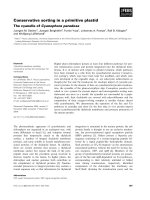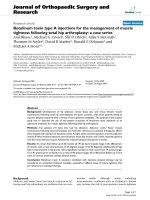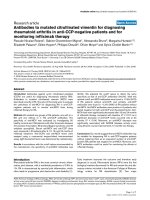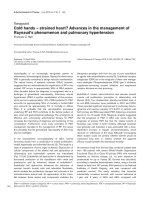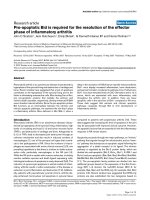Báo cáo y học: " How to select a chiropractor for the management of athletic condition" potx
Bạn đang xem bản rút gọn của tài liệu. Xem và tải ngay bản đầy đủ của tài liệu tại đây (162.8 KB, 4 trang )
BioMed Central
Page 1 of 4
(page number not for citation purposes)
Chiropractic & Osteopathy
Open Access
Debate
How to select a chiropractor for the management of athletic
conditions
Wayne Hoskins*, Henry Pollard and Peter Garbutt
Address: Macquarie Injury Management Group, Department of Health & Chiropractic, Macquarie University, Sydney, NSW 2109, Australia
Email: Wayne Hoskins* - ; Henry Pollard - ;
Peter Garbutt -
* Corresponding author
Abstract
Background: Chiropractors are an integral part of the management of musculoskeletal injuries.
A considerable communication gap between the chiropractic and medical professions exists.
Subsequently referring allopathic practitioners lack confidence in picking a chiropractic practitioner
with appropriate management strategies to adequately resolve sporting injuries. Subsequently, the
question is often raised: "how do you find a good chiropractor?".
Discussion: Best practice guidelines are increasingly suggesting that musculoskeletal injuries
should be managed with multimodal active and passive care strategies. Broadly speaking
chiropractors may be subdivided into "modern multimodal" or "classical" (unimodal) in nature. The
modern multimodal practitioner is better suited to managing sporting injuries by incorporating
passive and active care management strategies to address three important phases of care in the
continuum of injury from the acute inflammation/pain phase to the chronic/rehabilitation phase to
the injury prevention phase. In contrast, the unimodal, manipulation only and typically spine only
approach of the classical practitioner seems less suited to the challenges of the injured athlete.
Identifying what part of the philosophical management spectrum a chiropractor falls is important
as it is clearly not easily evident in most published material such as Yellow Pages advertisements.
Summary: Identifying a chiropractic practitioner who uses multimodal treatment of adequate
duration, who incorporates active and passive components of therapy including exercise
prescription whilst using medical terminology and diagnosis without mandatory x-rays or
predetermined treatment schedules or prepaid contracts of care will likely result in selection of a
chiropractor with the approach and philosophy suited to appropriately managing athletic
conditions. Sporting organizations and associations should consider using similar criteria as a
minimum standard to allow participation in health care team selections.
Background
Chiropractic has travelled a difficult path to recognition in
recent years. This is particularly true in the sports realm.
The authors of this commentary have a combined experi-
ence of sports representation at the national and interna-
tional level as practitioners, writing and teaching
academic sports chiropractic programs and published
research in sports chiropractic. The collective experience
of this group has led to the formulation of various opera-
tional guidelines that may be useful to other healthcare
Published: 10 March 2009
Chiropractic & Osteopathy 2009, 17:3 doi:10.1186/1746-1340-17-3
Received: 7 January 2009
Accepted: 10 March 2009
This article is available from: />© 2009 Hoskins et al; licensee BioMed Central Ltd.
This is an Open Access article distributed under the terms of the Creative Commons Attribution License ( />),
which permits unrestricted use, distribution, and reproduction in any medium, provided the original work is properly cited.
Chiropractic & Osteopathy 2009, 17:3 />Page 2 of 4
(page number not for citation purposes)
practitioners. However, it is important to recognise that
the views expressed in this work are those of the authors
and not any body to which they are affiliated.
This paper was inspired by interaction in a recent tutorial
provided by sports chiropractors to Australasian College
of Sports Physician (ACSP) Registrars as part of the official
ACSP training program. During the exchange it became
clear that there was a considerable communication gap
between the professions and the question was raised:
"how do you find a good chiropractor?" As with all pro-
fessions there is a difference in practitioner skill and
expertise, although this difference is perhaps more diverse
in chiropractic [1,2]. For many of the registrars this was
their first interface with a chiropractor, largely due to med-
ical schools and hospitals within Australia being separate
from chiropractic university education and training. Much
of what the registrars knew was from second hand infor-
mation although it was apparent that the registrars under-
stood that there were "good and bad chiropractors".
Chiropractors and manual therapists are an integral part
of the treatment of musculoskeletal injuries and disabili-
ties. Referring practitioners should have some under-
standing of the various types of chiropractors and
practitioners and the various treatments and modalities
used. The aim of this commentary is to provide a quick
reference guide for non-chiropractors to use in the selec-
tion of or referral to a chiropractor for the management of
athletic conditions.
Discussion
Chiropractic is a very broad primary contact healthcare
profession with an assortment of different technique and
philosophical groups [3]. A distinction has been made
such there are those who are called "modern multimodal"
(MMM) chiropractors and those who are "classical" chiro-
practors [4,5]. Hoskins et al. [4] have said that MMM chi-
ropractic management incorporates components of
passive and active care to address both the acute inflam-
mation/pain phase and the chronic/rehabilitation/injury
prevention phase. Management often begins with acute
injuries and continues through to the sub-acute or chronic
phase (if necessary), with management changing along
the path of patient recovery. After the pain and function
has normalised, many chiropractors and their patients
choose to pursue preventative strategies sometimes
referred to as wellness or performance based treatment.
Not all practitioners pursue this approach. Such MMM
management typically incorporates a combined approach
of various manual therapy procedures with an emphasis
on high-velocity low-amplitude manipulation, soft tissue
and stretching techniques, rehabilitation and therapeutic
exercises, and non-local biomechanical improvement to
improve kinematic and kinetic chain function. Other
modalities used include taping, physical therapies, elec-
trotherapeutics, acupuncture, gait retraining, nutrition,
footwear/ergonomic/training advice and exercise/cross
training programs. With spine-based management, psy-
chosocial and other risk factors for chronicity are typically
assessed at 4–6 weeks to avoid progression to chronic
debilitation, and similar approaches are important in the
prevention of chronic extremity injury. It should be noted
that the MMM approach is characteristic of the preferred
sports chiropractor [1] and is provided to all candidates in
undergraduate university education and training [6,7].
The MMM approach should be evidence based where data
is available to inform management.
Alternatively, classical chiropractors do not generally pro-
vide a multimodal treatment strategy incorporating soft
tissue approaches, physical therapies, active rehabilita-
tion, therapeutic exercise or pharmacological recommen-
dation [1]. These practitioners follow historically derived
approaches to patient management being typically uni-
modal in nature [1,4]. They characteristically utilise a
manipulation-only approach and often a spine-only
approach to address the osseous/joint component of
patient complaints and the reflex neurophysiological
changes secondary to the osseous/joint change [8,9].
However, athletes typically need direct active and/or pas-
sive management strategies to all tissues: osseous, muscle,
ligament and fascia at a spine and extremity level in a
patient centred approach to care rather than a practitioner
centred approach.
Subsequently, many of the classical practitioners that sub-
scribe to certain technique monotherapies and dated phil-
osophical beliefs are not suited to the management of
athletic injuries or athletic populations, whilst we con-
tend that many MMM chiropractors are so suited [1,9].
This is largely a result of classical chiropractors choosing
not to implement a management strategy that addresses
pain and acute inflammation in conventional ways, along
with rehabilitation or exercise prescription [1], all of
which are fundamental for the management of most
sporting injuries. The classical chiropractor often differen-
tiates themselves from MMM chiropractors on the basis
that they follow the "philosophical" view, or more cor-
rectly the historical view of chiropractic. It should be
noted that philosophy is a desire to gain knowledge, to
search and has nothing to do with the "belief" system that
many chiropractor's refer to as their "philosophy". This
belief system should also be supported by evidence too. It
should also be noted the classical style of chiropractic, as
with any older form of approach in health care is being
utilised by fewer chiropractors every year.
Identifying what part of the philosophical management
spectrum a chiropractor falls in is not clearly evident or
Chiropractic & Osteopathy 2009, 17:3 />Page 3 of 4
(page number not for citation purposes)
publicized. One cannot simply look in the "Yellow Pages"
to determine these facts. As a result, random selection or
referral to a chiropractor may be met with disappointing
results. Table 1 describes the key criteria and principles
that we feel are important in the identification of an
appropriate chiropractor. This table describes the
attributes and management strategies that are desirable if
they are to be suitable for the management of athletic
injuries. These attributes can be determined quickly dur-
ing a short phone inquiry by referring doctor or patient.
Although treatment should be individualized, the time of
treatment should be no less than 15–20 minutes, which
coincidentally is the requirement for the Australian Medi-
care allied health referral system [10]. Although the type
of treatment rendered is often a function of time, treat-
ment should also be multimodal in nature. The manual
therapy and chiropractic literature and education suggests
the multimodal approach as the logical way to patient
management. Clearly this form of management cannot be
rendered within a 2–5 minute treatment time frame that
some high volume practitioners operate under, particu-
larly those chiropractors that are spine-only and manipu-
lation-only in their approach. Neither is it conceivable
that risk assessment nor re-evaluation for rational contin-
uation of treatment can be done in this space of time. In
the absence of evidence that suggests that 2–5 minute
treatment is better than multimodal treatment of 15–20
minute duration, the multimodal approach should be fol-
lowed. It is up to the 2–5 minute practitioners to provide
evidence that their particular approach is superior to the
other longer treatment, which is supported by a larger
body of published literature. Management of spine and
extremity conditions should be with local and often non-
local management strategies. Such approaches are consist-
ent with approaches by other healthcare professions such
as physiotherapy and osteopathy, although differences
exist in application [11].
The chiropractor like all practitioners should operate uti-
lising an evidence based approach for all components of
therapy including the provision of radiographs [12-14].
Essentially the patient should not receive mandatory x-
rays as a requirement of treatment unless indicated [13].
They should also have knowledge of when to refer for
advanced forms of imaging such as CT, MRI and diagnos-
tic ultrasound and know the indications of when to refer
[12]. Chiropractors should also be conversant with and be
expected to communicate with patients and referring prac-
titioners through standard medical terminology [15].
Diagnosis and explanation should be provided and
expressed in terms of these medical descriptions, not
'unique' chiropractic language, descriptions, or jargon
[15]. This will assist with corresponding with all members
of the health care team with language and descriptions
that everyone understands. An inability or unwillingness
to do so demonstrates and incapability to work in a team
based, multidisciplinary environment, a long-standing
criticism of some chiropractors [1].
Furthermore, the chiropractor should not provide prede-
termined treatment schedules or prepaid contracts of care,
which do not fit with individualized and patient centred
approaches to management [16]. Management should be
based on a case-by-case basis. The 'one size fits all' pre-
paid contracts and other practice management schemes
are strongly discouraged by the leaders and majority of the
chiropractic profession and have been the source of many
complaints in Australia [17].
All chiropractors are familiar with risk management for
safety and medicolegal reasons and should implement
them actively in the provision of care [18,19]. This will
result in appropriate practices for patient screening and
selection for treatment and choice of treatment modality.
The chiropractor should perform a complete and thor-
ough history and physical examination prior to deciding
to embark upon treatment of the injured athlete, just like
any other practitioner. Not limited to this, screening
should include standardized orthopaedic, neurological,
joint based assessment (e.g. static and motion palpation)
and other testing procedures, assessment of vital signs and
– despite recent literature – vertebro-basilar insufficiency
testing where appropriate for medicolegal purposes
[20,21]. It is expected that athletes receive an appropriate
individualized history in a traditional medical sense,
which should assist with ruling out red flag conditions
prior to the physical examination and other testing proce-
dures. Additionally, it is likely that the sports specific his-
tory and examination should include analysis of training
and competition needs, including specific biomechanical
analysis/investigation of function commensurate with the
level of play. Importantly, all practitioners should be
aware of their limitations with certain conditions and
Table 1: Key criteria and principles which the chiropractor
should demonstrate if they are to be suitable for the
management of athletic injuries
Minimum treatment time 15–20 minutes
Treatment is multimodal in nature
Treatment should contain active (exercises) and passive components
No mandatory x-rays required for treatment
No predetermined treatment schedules or prepaid contracts of care
Use of medical terminology and diagnosis
* The criteria and principles are based on direct questions provided
by Australasian College of Sports Physician Registrars
Chiropractic & Osteopathy 2009, 17:3 />Page 4 of 4
(page number not for citation purposes)
partner with other medical team members to provide a
full range of service to the athlete [4]. Only when such
complimentary services are offered do we as practitioners
truly provide patient centred health care.
Summary
When trying to select or find a chiropractor to refer to, one
would ask the questions of the chiropractor based on the
characteristics listed in Table 1 to ascertain whether the
chiropractor fits these criteria. It is the authors' opinion
that a chiropractor possessing all of the criteria would be
equipped with the approach and philosophy to appropri-
ately manage athletic conditions. The authors also recom-
mend that sporting organizations and associations use
similar criteria as a minimum standard to allow participa-
tion in health care team selections.
Conclusion
The purpose of this paper was to facilitate communication
between the chiropractic and medical and allied health
care professions in the attempt to maximise athlete
patient care outcomes. When referring practitioners or
athletic patients, following the quick and simple
approach for assessment of a chiropractor's management
approaches and philosophies, will likely find suitable
practitioners committed to working together in a multi-
disciplinary approach to enhance the health of their ath-
letic patients.
Competing interests
The authors have no conflict of interest that is directly rel-
evant to the content of this manuscript. No source of
funding was used in the preparation of this manuscript.
Authors' contributions
WH and HP presented the tutorial to the Australasian Col-
lege of Sports Physician (ACSP) Registrars and conceived
the idea of the paper. At a series of meetings, email and
phone conversations WH, HP and PG further developed
the discussion of the paper. All authors contributed to
writing an initial draft document that reflected the collec-
tive thoughts and experiences of the participants. Over a
course of further meetings, email and phone conversa-
tions, all authors contributed to the writing and re-writing
of this paper. All authors made original contributions to
the content of the final manuscript. All of the authors par-
ticipated in the editing and revisions of the multiple drafts
that existed between the initial and final draft. All authors
read and approved the final manuscript.
References
1. Pollard H, Hoskins W, McHardy A, Bonello R, Garbutt P, Swain M,
Dragasevic G, Pribicevic M, Vitiello A: Australian chiropractic
sports medicine: half way there or living on a prayer? Chiropr
Osteopat 2007, 15:14.
2. Seaman D: Philosophy and science versus dogmatism in the
practice of chiropractic. J Chiropr Humanities 1998, 8:55-66.
3. Keating JC Jr, Charlton KH, Grod JP, Perle SM, Sikorski D, Winter-
stein JF: Subluxation: dogma or science? Chiropr Osteopat 2005,
13:17.
4. Hoskins W, McHardy A, Pollard H, Windsham R, Onley R: Chiro-
practic treatment of lower extremity conditions: a literature
review. J Manipulative Physiol Ther 2006, 29(8):658-71.
5. McHardy A, Hoskins W, Pollard H, Onley R, Windsham R: Chiro-
practic treatment of upper extremity conditions: a system-
atic review. J Manipulative Physiol Ther 2008, 31(2):146-59.
6. Macquarie University: Chiropractic (Undergraduate Study Pat-
tern) [online]. Macquarie University. [Accessed 14th March
2009]. 2008 [ />ate/Programs/ProgramOfStudy.php?ProgramCode=CHRP01].
7. Macquarie University: Chiropractic (Postgraduate Study Pat-
tern) [online]. Macquarie University. [Accessed 14th March
2009]. 2008 [ />Programs/ProgramOfStudy.php?ProgramCode=CHRP01P].
8. Christensen MG, Kollasch MW: Overview of Survey Response.
In: Job Analysis of Chiropractic: A Project Report, Survey
Analysis and Summary of the Practice of Chiropractic within
the United States. Greeley, Colorado. National Board of Chiropractic
Examiners 2005:65-75.
9. Christensen MG, Kollasch MW: Professional Functions and
Treatment Procedures. Job Analysis of Chiropractic: A
Project Report, Survey Analysis and Summary of the Prac-
tice of Chiropractic within the United States. Greeley, Colorado.
National Board of Chiropractic Examiners 2005:121-138.
10. Australian Government: Australian Government Department
of Health and Ageing Enhanced Primary Care Program.
Allied Health Services Under Medicare – Fact Sheet
[online]. Australia [Accessed 21
st
December 2008]. 2008
[ />health-medicare-health_pro-gp-pdf-allied-cnt.htm].
11. Veen EA van de, de Vet HC, Pool JJ, Schuller W, de Zoete A, Bouter
LM: Variance in manual treatment of nonspecific low back
pain between orthomanual physicians, manual therapists,
and chiropractors. J Manipulative Physiol Ther 2005, 28(2):108-116.
12. French SD, Walker BF, Cameron M, Pollard HP, Vitiello AL, Reggars
JW, Werth PD, Comrie DA: Risk management for chiroprac-
tors and osteopaths: Imaging Guidelines for Conditions
Commonly Seen in Practice. Australas Chiropr Osteopathy 2003,
11(2):41-8.
13. Anderson RE, Drayer BP, Braffman B, Davis PC, Deck MD, Hasso AN,
Johnson BA, Masaryk T, Pomeranz SJ, Seidenwurm D, Tanenbaum L,
Masdeu JC: Acute low back pain–radiculopathy. American
College of Radiology. ACR Appropriateness Criteria. Radiol-
ogy 2000, 215(Suppl):479-85.
14. Australian Government: Australian Acute Musculoskeletal Pain
Guidelines Group. Evidence-based management of Acute
Musculoskeletal pain. National Health and Medical Research
Council [Accessed 21
st
December 2008]. 2003 [http://
www.nhmrc.gov.au/publications/synopses/_files/cp94.pdf].
15. Brussee WJ, Assendelft WJ, Breen AC: Communication between
general practitioners and chiropractors. J Manipulative Physiol
Ther 2001, 24(1):12-6.
16. Charlton KH: Silence is not golden: it's consent. Chiropr J Aust
2003, 33(3):81-2.
17. Chiropractors Registration Board of Victoria: Standard of Practice
Codes: Pre-Paid Contracts of Care. Chiropractors Registra-
tion Board of Victoria [Accessed 21
st
December 2008]. 2007
[ />].
18. Walker BF, Cameron M, French S, Pollard HP, Vitiello AL, Reggars
JW, Werth PD: Risk Management for Chiropractors and Oste-
opaths. Informed consent: A Common Law Requirement.
Australas Chiropr Osteopathy 2004, 12(1):19-23.
19. Reggars JW, French SD, Walker BF, Cameron M, Pollard H, Vitiello
A, Werth PD: Risk Management for Chiropractors and Oste-
opaths: Neck Manipulation & Vertebrobasilar Stroke. Aus-
tralas Chiropr Osteopathy 2003, 11(1):9-15.
20. Mitchell J: Doppler insonation of vertebral artery blood flow
changes associated with cervical spine rotation: Implications
for manual therapists. Physiother Theory Pract 2007, 23(6):303-13.
21. Thomas LC, Rivett DA, Bolton PS: Pre-manipulative testing and
the use of the velocimeter. Man Ther 2008, 13(1):29-36.




